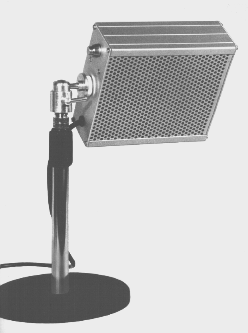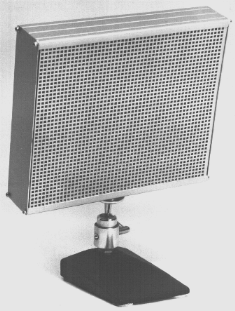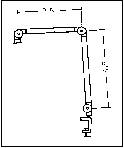Soldering Solder - Fume
Distelkamp - Electronic
Ernst Christmann Str. 8, D-67659 Kaiserslautern
Phone: 49-631-78319, fax,: 49-631-78399, e-mail,:
dikamp@aol.com
Solder fume and pollutant
absorbers
For the sake of your health.
Should not be missing at any workstation.
By using our absorbers, poisonous and smelly gases, vapors,
aerosols, and floating particles are vacuumed at the place of
formation. Direct skin-and breath-contact as well as diffusion
into the air is prevented. The exhaust air, cleaned through active
carbon, is supplied back to the area again. Heat-loss and drafts
are therefore eliminated. As opposed to installing absorbing stations,
these absorbers have the following advantages:
- The workstation-formation remains flexible, because the
appliances are not permanently installed.
- No maintenance costs originate, since cleaning of the
vacuum hoses is eliminated.
- If one unit should fail, down-time of the entire installation
does not occur.
- Lower energy-consumption.
- The units have proven themselves for years a thousandfold.
Our absorbers are recommended by the occupation-cooperative,
the institute for labor safety of the Federal-institution of labor,
the technical labor safety service for Federal employees, etc
Due to equal production of pollutant and solder vapor absorbers
for virtually all industry-branches we can produce these units
inexpensively. That means low initial purchase cost and overhead.
Areas of Application:
- Chemical industry
- Drug industry
- Hospital, laboratory-doctor,
- Drugstores
- Dental laboratory
- Electronics industry
- Solders in metal-processing
- Plastic-processing
- Glues and solvent vapors
- Goldsmiths
- Restoration
- Schools and universities
- Tiffany technique
Solder Fume Absorber LDA 11
 Useful appliance with adjustable inclination, that fully suffices
average requirements with smaller soldering jobs. Based on the
attractive price and the practical construction, this absorber
is suitable for schools, home industry and training. The appliance
comes with its own mount or stand.
Useful appliance with adjustable inclination, that fully suffices
average requirements with smaller soldering jobs. Based on the
attractive price and the practical construction, this absorber
is suitable for schools, home industry and training. The appliance
comes with its own mount or stand.
Power requirements::220/240V/18W, air throughput:160m³/h,
noise level: 40dBA, housing: anodized aluminum, dimensions: 150x140x55mm
Order-numbers:
- LDA 11 Solder Fume Absorber: EUR 54,80
- LDF 1 pack replacement filters (6 pcs) EUR 12,22
+Sales Tax.
Solder Fume Absorber LDA 1
 A well proven unit, with robust aluminum-casing and pierced front-plate,
that cannot be inadvertently damaged by hot solder tips. The absorber
can be used either as a table appliance or higher up with a tripod,
to be ordered seperately (with round base), with variable inclination
angle. Power requirement: 220/240V/18W, air throughput: 170m³/h,
noise level: 40dBA, housing: anodized aluminum, dimensions: 150x140x55mm
A well proven unit, with robust aluminum-casing and pierced front-plate,
that cannot be inadvertently damaged by hot solder tips. The absorber
can be used either as a table appliance or higher up with a tripod,
to be ordered seperately (with round base), with variable inclination
angle. Power requirement: 220/240V/18W, air throughput: 170m³/h,
noise level: 40dBA, housing: anodized aluminum, dimensions: 150x140x55mm
Order-numbers:
- LDA 1 Solder vapor absorbers EUR 63,66
- LDS 1 tripod with base EUR 30,00
- LDF 1 pack replacement filters (6
pcs.) EUR 12,22
+Sales Tax.
Solder Fume Absorber LDA 4
 Power requirements: 220/240V 16W, air throughput: 320m³/h,
noise level: 36dBA, housing: anodized aluminum, dimensions: 260x230x55mm.
Through the use of 4 low noise fans, the noise level amounts to
only 36 dBAs. Consequently, the LDA 4 is the quietest absorber
on the market. The 4 fans cause an even air throughput over the
entire surface of 260x220mm. Through a new technology, we have
succeeded in reaching an air throughput of 320m³/h with an
input of only 16W. The life expectancy of the filter is about
4-6 weeks with a run time of approximately 8 hours per day. Due
to the high air throughput with minimal noise development, this
unit is suitable for virtually any job.
Power requirements: 220/240V 16W, air throughput: 320m³/h,
noise level: 36dBA, housing: anodized aluminum, dimensions: 260x230x55mm.
Through the use of 4 low noise fans, the noise level amounts to
only 36 dBAs. Consequently, the LDA 4 is the quietest absorber
on the market. The 4 fans cause an even air throughput over the
entire surface of 260x220mm. Through a new technology, we have
succeeded in reaching an air throughput of 320m³/h with an
input of only 16W. The life expectancy of the filter is about
4-6 weeks with a run time of approximately 8 hours per day. Due
to the high air throughput with minimal noise development, this
unit is suitable for virtually any job.
Tripod with Pivot Arm LDS 10
 The tripod for highest demands. Through three stable joints, the
tripod can be positioned very well. It is delivered complete with
ball and socket joints and a clamp. The tripod with pivot arm
is suitable for all absorbers.
The tripod for highest demands. Through three stable joints, the
tripod can be positioned very well. It is delivered complete with
ball and socket joints and a clamp. The tripod with pivot arm
is suitable for all absorbers.
Order-numbers:
- LDA 4 pollutant absorber EUR 176,40
- LDS 6 table tripods EUR 49,00
- LDS 10 tripod with pivot arm EUR 107,50
- LDF 4 replacement filter EUR 8,70
+ Sales Tax.
Pollutant- and Solder Fume Absorber
LDA 600
 Through the use of 6 axial-fans, the air throughput is distributed
evenly over the entire surface. The high vacuum performance makes
this unit suitable for all jobs, even with large quantities of
pollution and further distance to the source of the pollution.
This absorber surpasses in its performance almost all permanently
installed vacuuming equipment and workstation arrangements remain
flexible. Power requirements: 220/240V 110W, air throughput: 650m³/h,
noise level: 42dBA, housing: anodized aluminum, dimension: 445x260x55mm
Through the use of 6 axial-fans, the air throughput is distributed
evenly over the entire surface. The high vacuum performance makes
this unit suitable for all jobs, even with large quantities of
pollution and further distance to the source of the pollution.
This absorber surpasses in its performance almost all permanently
installed vacuuming equipment and workstation arrangements remain
flexible. Power requirements: 220/240V 110W, air throughput: 650m³/h,
noise level: 42dBA, housing: anodized aluminum, dimension: 445x260x55mm
Order-numbers:
- LDA 600 pollutant-absorbers complete with tripod EUR 253,10
- LDF 600 replacement filter EUR 17,39
+ Sales Tax.
- All prices are excluding Sales Tax
- Prices are from factory, incl. Package.
- Over EUR 250.--net free house
- Foreign country: over EUR 250.--net free German border
- Payable: 14 days 2% discounts, 30 days net
- On all units 2 year warranty.
Distelkamp - Electronic
- Ernst Christmann Str. 8, D-67659
Kaiserslautern
Phone: 49-631-78319, fax,: 49-631-78399, e-mail,: dikamp@aol.com
Biting Solder Fumes are a Thing of the
Past
Vacuum units and filters are state of the art
- Soldering techniques used in today's electronics industry
are usually the hard solder, soft solder, as well as the flame
soldering with solder paste, flux or solder wire filled with
flux. These are alloys, that, in comparison to pure metal, clearly
show lower boiling- and melting points, and therefore convert
more quickly to the evaporation phase. With these alloys, the
lasting bond of materials is guaranteed, without a change in
the materials themselves. Solder contains aluminum, tin, lead,
zinc, cadmium, silver and copper depending on the alloy-type
and melting point. A typical soft solder consists of 60% pewter
and 40% lead. A hard solder, on the other hand, contains 75%
silver and 25% cadmium. The danger to one's health in hard and
soft solder is mainly contributed to lead and cadmium. Lead is
a heavy metal causing long-term damage. It impairs the formation
of new red blood cells and damages the central nervous system.
Therefore, the legislation has enacted strict laws in the contact
with lead and has set a limit of a maximum concentration of 0,1mg
per cubic meters of airspace at the work place. According to
the dangerous material ordinance, contact with lead is prohibited
for child bearing women, if the MAK-value or the biological working-material-value
(BAT) cannot be maintained. For women up to 45 years of age,
the BAT-value amounts to 30ug/100ml blood. This value lies only
slightly above the blood-lead-value of the average German citizen.
A value of 70ug/100ml blood applies to men. The edition of solder
work with lead containing solder in the home industry is subject
to strict regulations. Cadmium is already prohibited in Sweden.
In the Federal republic, this metal is classified as a carcinogenic
material of the group AT II. That means, in animal experiments
cadmium has proven to be cancer-causing, in fact, under conditions,
that correspond to the exposure at the job. The virulence of
Cadmium became known through the Itai-Itai-Illness, a rachitis
similar to bone-brittleness. A technical guideline does not exist
for cadmium concentration. However, the minimization-rule is
valid. Currently under discussion is a TRK-value of 0,02mg per
cubic meter. Cadmium containing solder must be marked since 1990
according to the dangerous material ordinance. In order to guarantee
that the solder joint remains durable, no disturbing oxide-layer
may exist on the workpiece before soldering. Liquid chemicals
ensure the removal of these oxide layers. Known such chemicals
are talc, ammonium salt, borax, colophon, tin - and zinc-chloride,
organic acids, (Amine and Hydrazin)???. The "Hydrazin"
as well as the colophon are the most problematic. "Hydrazin"
is similar to cadmium; the material is replaceable, however.
colophon is a rosin containing liquid chemical, that contains
"Abietinsäure" as a main component. Normal soldering
temperatures can lead to the partial decomposition of the colophon,
which, among other things, creates aldehydes. The best known
of this organic chemical is formaldehyde, a material, that is
under heavy public discussion. Formaldehyde is also examined
for its carcinogenic effect at this time. The MAK-value lies
at 0,5 ppm. This short overview shows which health-related dangers
need to be taken into account when soldering. According to the
current regulations (accident prevention regulation VBG 15),
vacuum equipment is required for the respective work stations.
The air may only be led back into the area, if it was filtered
in accordance with this rule. The filters are to be renewed at
regular intervals.
Distelkamp - Electronic
Ernst Christmann Str. 8,
D-67659 Kaiserslautern
Phone: 49-631-78319, fax,:
49-631-78399, e-mail,:
dikamp@aol.com
 Useful appliance with adjustable inclination, that fully suffices
average requirements with smaller soldering jobs. Based on the
attractive price and the practical construction, this absorber
is suitable for schools, home industry and training. The appliance
comes with its own mount or stand.
Useful appliance with adjustable inclination, that fully suffices
average requirements with smaller soldering jobs. Based on the
attractive price and the practical construction, this absorber
is suitable for schools, home industry and training. The appliance
comes with its own mount or stand. A well proven unit, with robust aluminum-casing and pierced front-plate,
that cannot be inadvertently damaged by hot solder tips. The absorber
can be used either as a table appliance or higher up with a tripod,
to be ordered seperately (with round base), with variable inclination
angle. Power requirement: 220/240V/18W, air throughput: 170m³/h,
noise level: 40dBA, housing: anodized aluminum, dimensions: 150x140x55mm
A well proven unit, with robust aluminum-casing and pierced front-plate,
that cannot be inadvertently damaged by hot solder tips. The absorber
can be used either as a table appliance or higher up with a tripod,
to be ordered seperately (with round base), with variable inclination
angle. Power requirement: 220/240V/18W, air throughput: 170m³/h,
noise level: 40dBA, housing: anodized aluminum, dimensions: 150x140x55mm Power requirements: 220/240V 16W, air throughput: 320m³/h,
noise level: 36dBA, housing: anodized aluminum, dimensions: 260x230x55mm.
Through the use of 4 low noise fans, the noise level amounts to
only 36 dBAs. Consequently, the LDA 4 is the quietest absorber
on the market. The 4 fans cause an even air throughput over the
entire surface of 260x220mm. Through a new technology, we have
succeeded in reaching an air throughput of 320m³/h with an
input of only 16W. The life expectancy of the filter is about
4-6 weeks with a run time of approximately 8 hours per day. Due
to the high air throughput with minimal noise development, this
unit is suitable for virtually any job.
Power requirements: 220/240V 16W, air throughput: 320m³/h,
noise level: 36dBA, housing: anodized aluminum, dimensions: 260x230x55mm.
Through the use of 4 low noise fans, the noise level amounts to
only 36 dBAs. Consequently, the LDA 4 is the quietest absorber
on the market. The 4 fans cause an even air throughput over the
entire surface of 260x220mm. Through a new technology, we have
succeeded in reaching an air throughput of 320m³/h with an
input of only 16W. The life expectancy of the filter is about
4-6 weeks with a run time of approximately 8 hours per day. Due
to the high air throughput with minimal noise development, this
unit is suitable for virtually any job. The tripod for highest demands. Through three stable joints, the
tripod can be positioned very well. It is delivered complete with
ball and socket joints and a clamp. The tripod with pivot arm
is suitable for all absorbers.
The tripod for highest demands. Through three stable joints, the
tripod can be positioned very well. It is delivered complete with
ball and socket joints and a clamp. The tripod with pivot arm
is suitable for all absorbers. Through the use of 6 axial-fans, the air throughput is distributed
evenly over the entire surface. The high vacuum performance makes
this unit suitable for all jobs, even with large quantities of
pollution and further distance to the source of the pollution.
This absorber surpasses in its performance almost all permanently
installed vacuuming equipment and workstation arrangements remain
flexible. Power requirements: 220/240V 110W, air throughput: 650m³/h,
noise level: 42dBA, housing: anodized aluminum, dimension: 445x260x55mm
Through the use of 6 axial-fans, the air throughput is distributed
evenly over the entire surface. The high vacuum performance makes
this unit suitable for all jobs, even with large quantities of
pollution and further distance to the source of the pollution.
This absorber surpasses in its performance almost all permanently
installed vacuuming equipment and workstation arrangements remain
flexible. Power requirements: 220/240V 110W, air throughput: 650m³/h,
noise level: 42dBA, housing: anodized aluminum, dimension: 445x260x55mm